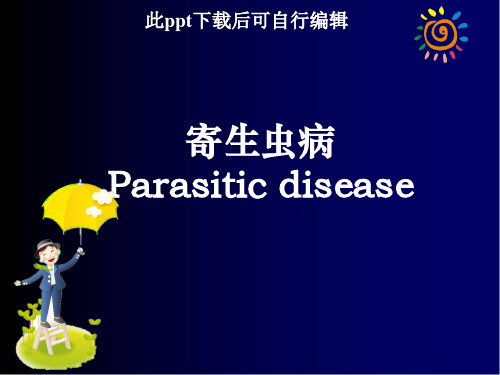寄生虫病的诊断.ppt
合集下载
《人体寄生虫》课件

影像学诊断
通过X线、超声、CT等 影像学手段观察寄生虫 在体内的位置和形态。
临床表现诊断
根据患者的临床表现和 流行病学资料,结合寄 生虫的生物学特性进行
诊断。
治疗原则
01
02
03
04
早期治疗
一旦确诊,应尽早开始治疗, 以避免寄生虫对人体的进一步
损害。
足量用药
确保药物剂量充足,以保证治 疗效果。
联合用药
防治人体寄生虫的重要性
保护个体健康
防治寄生虫感染可以预防寄生虫病的发生, 保护个体健康。
提高生活质量
防治寄生虫感染可以改善人们的营养状况和 生活质量。
促进社会公共卫生
防治寄生虫感染可以降低寄生虫病的传播风 险,有利于社会公共卫生。
科学研究价值
研究人体寄生虫的防治方法和机制,有助于 推动寄生虫病防治的科学研究和发展。
钩虫
症状
钩虫感染的症状包括腹痛、腹泻 、体重下降、疲劳和贫血等。
传播途径
钩虫主要通过人体皮肤接触污染的 土壤或水传播。
预防措施
预防钩虫感染的关键是避免接触可 能被污染的土壤和水,同时注意个 人卫生,如勤洗手、不赤脚行走等 。
鞭虫
症状
鞭虫感染的症状包括腹痛、腹泻 、体重下降、食欲不振等。
传播途径
鞭虫主要通过人体摄入污染的食 物和水传播。
人体寄生虫对人体的影响
要点一
总结词
人体寄生虫对人体的影响是多方面的,包括机械性损伤、 化学性刺激和免疫反应等。
要点二
详细描述
机械性损伤是指寄生虫在人体内移动过程中对器官或组织 的损伤,如蛔虫在肠道内移动可能会引起肠道出血或炎症 。化学性刺激是指寄生虫产生的代谢产物或分泌物质对人 体的刺激,如钩虫分泌的毒素可能会引起人体过敏反应。 免疫反应是指寄生虫对人体免疫系统的刺激,可能会引起 人体过敏反应或导致免疫系统疾病。
寄生虫病PPT课件

寄生虫病ppt课件
汇报人:可编辑 2024-01-11
目 录
• 引言 • 寄生虫病的传播途径 • 常见的寄生虫病及其症状 • 寄生虫病的预防与控制 • 寄生虫病的诊断与治疗 • 寄生虫病的预防与控制案例分析
01
引言
寄生虫病的定义与分类
定义
寄生虫病是指寄生虫侵入人体或 动物体内,引起人或动物发生疾 病。
避免接触感染源
避免接触可能被寄生虫污染的水、 土壤或动物,特别是在流行地区。
环境卫生改善
改善水源
确保家庭饮用水来自清洁、安全 的来源,并定期进行水质检测。
垃圾处理
正确处理生活垃圾,避免污染水 源和土壤。
卫生设施
确保家庭和公共卫生设施的清洁 和正常使用。
药物治疗与疫苗接种
遵医嘱治疗
01
一旦感染寄生虫病,应立即就医并遵医嘱治疗。
03
常见的寄生虫病及其症状
蛔虫病
01
02
03Leabharlann 症状食欲不振、腹泻、体重下 降、腹痛、磨牙、异食癖 等。
传播途径
通过污染的食物或水经口 摄入感染。
预防措施
注意个人卫生,勤洗手, 不喝生水,生熟食物分开 等。
钩虫病
症状
咳嗽、气喘、发热、乏力 、腹泻、贫血等。
传播途径
通过接触污染的土壤或生 食污染的蔬菜感染。
分类
寄生虫病可以根据寄生虫的种类 、寄生部位、感染途径等进行分 类,如肠道寄生虫病、血液寄生 虫病、组织寄生虫病等。
寄生虫病的危害与影响
危害
寄生虫病对人类和动物的健康造成严 重影响,可导致营养不良、贫血、免 疫系统损伤、生长发育障碍等。
影响
寄生虫病不仅对个体健康造成危害, 还对整个社会和经济产生影响,如劳 动力丧失、医疗费用增加等。
汇报人:可编辑 2024-01-11
目 录
• 引言 • 寄生虫病的传播途径 • 常见的寄生虫病及其症状 • 寄生虫病的预防与控制 • 寄生虫病的诊断与治疗 • 寄生虫病的预防与控制案例分析
01
引言
寄生虫病的定义与分类
定义
寄生虫病是指寄生虫侵入人体或 动物体内,引起人或动物发生疾 病。
避免接触感染源
避免接触可能被寄生虫污染的水、 土壤或动物,特别是在流行地区。
环境卫生改善
改善水源
确保家庭饮用水来自清洁、安全 的来源,并定期进行水质检测。
垃圾处理
正确处理生活垃圾,避免污染水 源和土壤。
卫生设施
确保家庭和公共卫生设施的清洁 和正常使用。
药物治疗与疫苗接种
遵医嘱治疗
01
一旦感染寄生虫病,应立即就医并遵医嘱治疗。
03
常见的寄生虫病及其症状
蛔虫病
01
02
03Leabharlann 症状食欲不振、腹泻、体重下 降、腹痛、磨牙、异食癖 等。
传播途径
通过污染的食物或水经口 摄入感染。
预防措施
注意个人卫生,勤洗手, 不喝生水,生熟食物分开 等。
钩虫病
症状
咳嗽、气喘、发热、乏力 、腹泻、贫血等。
传播途径
通过接触污染的土壤或生 食污染的蔬菜感染。
分类
寄生虫病可以根据寄生虫的种类 、寄生部位、感染途径等进行分 类,如肠道寄生虫病、血液寄生 虫病、组织寄生虫病等。
寄生虫病的危害与影响
危害
寄生虫病对人类和动物的健康造成严 重影响,可导致营养不良、贫血、免 疫系统损伤、生长发育障碍等。
影响
寄生虫病不仅对个体健康造成危害, 还对整个社会和经济产生影响,如劳 动力丧失、医疗费用增加等。
常见寄生虫病实验室检查及诊断进展61页PPT

➢ 从患者周围血液中检出疟原虫,是疟疾确诊的依据。 一般从受检者耳垂或指尖采血作薄血膜和厚血膜涂片, 以姬氏染液或瑞氏染液染色后镜检。
寄生虫病的实验室检查技术进展
免疫学检查由于寄生虫本身的代谢特点及其形态学的多变性,
普通的病原学方法不易做出检测,简便、快速、敏感的免疫学诊 断试验倍受关注和青睐。
➢ 原虫感染如棘阿米巴眼病可取患者的角膜刮片材料、 手术切除的角膜材料直接用氢氧化钾湿封片检查或进 行棘阿米巴的培养,然后于显微镜下检查找到其包囊 而确诊
寄生虫病的实验室检查技术进展
➢ 肠道线虫、吸虫或绦虫感染的患者,均可在其粪便中 找到虫卵而确诊。
➢ 吸虫感染如血吸虫病患者还可利用毛蚴孵化法。
➢ 丝虫病的确诊有赖于在血涂片或其他体液涂片中找到 微丝幼,并确定其虫种。
➢ 可对寄生虫不同发育阶段、机体不同感染部位及不同感染阶段、 不同的感染程度等情况都可通过对抗原或抗体进行检测
寄生虫病危害与流行现状
带绦虫病/囊尾蚴病 在我国感染此病的地区广泛分布于 包括台湾省在内的29个省(市、自治区)。在云、贵、 川等地一些少数民族喜食生猪肉,受到的威胁更大。
人绦虫病是由猪带绦虫和牛带绦虫而引起,据估计我 国有55万人感染绦虫病。约300万人感染人体囊尾蚴病。
肺吸虫病/并殖吸虫病 在我国,动物或人有并殖吸虫病 报告的省,市达20多个,包括福建、江西、重庆、湖北、 安徽等。2005年全国调查中,并殖吸虫病血清学阳性率 最高的为上海(5.14%),其次为重庆(4.12%)
寄生虫引起的疾病
19种对中枢神经系统造成损害;20种寄生虫寄生于人眼; 26种虫体能对肺造成损害;23种可损伤肝组织; 17种可引起阑尾炎;12种能引起腹腔内空腔脏器穿孔或
实质性脏器破裂;9种可引起肠梗阻; 45种能引起腹泻;10种引起胆囊炎、胆管炎或胆石症; 9种可直接或问接侵犯心脏;20种可损害泌尿生殖系统; 37种可不同程度损害皮肤; 29种可不同程度地引起贫血;7种可引起侏儒症; 8种机会性感染是艾滋病死亡的重要病因
寄生虫病的实验室检查技术进展
免疫学检查由于寄生虫本身的代谢特点及其形态学的多变性,
普通的病原学方法不易做出检测,简便、快速、敏感的免疫学诊 断试验倍受关注和青睐。
➢ 原虫感染如棘阿米巴眼病可取患者的角膜刮片材料、 手术切除的角膜材料直接用氢氧化钾湿封片检查或进 行棘阿米巴的培养,然后于显微镜下检查找到其包囊 而确诊
寄生虫病的实验室检查技术进展
➢ 肠道线虫、吸虫或绦虫感染的患者,均可在其粪便中 找到虫卵而确诊。
➢ 吸虫感染如血吸虫病患者还可利用毛蚴孵化法。
➢ 丝虫病的确诊有赖于在血涂片或其他体液涂片中找到 微丝幼,并确定其虫种。
➢ 可对寄生虫不同发育阶段、机体不同感染部位及不同感染阶段、 不同的感染程度等情况都可通过对抗原或抗体进行检测
寄生虫病危害与流行现状
带绦虫病/囊尾蚴病 在我国感染此病的地区广泛分布于 包括台湾省在内的29个省(市、自治区)。在云、贵、 川等地一些少数民族喜食生猪肉,受到的威胁更大。
人绦虫病是由猪带绦虫和牛带绦虫而引起,据估计我 国有55万人感染绦虫病。约300万人感染人体囊尾蚴病。
肺吸虫病/并殖吸虫病 在我国,动物或人有并殖吸虫病 报告的省,市达20多个,包括福建、江西、重庆、湖北、 安徽等。2005年全国调查中,并殖吸虫病血清学阳性率 最高的为上海(5.14%),其次为重庆(4.12%)
寄生虫引起的疾病
19种对中枢神经系统造成损害;20种寄生虫寄生于人眼; 26种虫体能对肺造成损害;23种可损伤肝组织; 17种可引起阑尾炎;12种能引起腹腔内空腔脏器穿孔或
实质性脏器破裂;9种可引起肠梗阻; 45种能引起腹泻;10种引起胆囊炎、胆管炎或胆石症; 9种可直接或问接侵犯心脏;20种可损害泌尿生殖系统; 37种可不同程度损害皮肤; 29种可不同程度地引起贫血;7种可引起侏儒症; 8种机会性感染是艾滋病死亡的重要病因
寄生虫病ppt课件

病因
蛔虫:
寄生人体肠道线虫中体型最大者; 雌雄异体,似蚯蚓,粉红色或微黄色; 成虫寄生于小肠,以肠内容物为食物; 雌虫每天排卵20万个,寿命1-2年。 随粪便排出的蛔虫卵在适宜环境下5-10 天发育成熟即具感染性; 人体感染到雌虫产卵约需60-75天。
病因
蛔虫生活史:
咽下←气管←支气管←肺泡←肺脏 ↓ ↑ 虫卵吞食→幼虫破卵而出→的症状:
食欲不振,多食易饥,异食癖;脐周 腹痛,喜按揉,不剧烈;烦躁易惊,萎 靡,磨牙;虫体异种蛋白可引起荨麻疹 等过敏症状;营养不良,生长发育慢。
临床表现
3、并发症:
胆道蛔虫症
蛔虫性肠梗阻
肠穿孔、腹膜炎
诊断、鉴别诊断
诊断: 有临床症状、体征、排蛔虫或 呕吐蛔虫史、粪便查到蛔虫卵即可 确诊;血中嗜酸性粒细胞增高,协 助诊断。 鉴别诊断: 出现并发症时与其他外科急腹 症鉴别。
临床表现
2、成虫引起的症状:
(1)贫血:为失血性,表现为不同程度 贫血,皮肤粘膜苍白、乏力、眩晕、影 响小儿体格和智力发育,严重者可发生 贫血性心脏病。 (2)消化道症状:贪食、多食易饥,体 重下降,后期食欲下降,胃肠功能紊乱、 腹胀不适、异食癖,营养不良等,严重 者便血。
临床表现
3、婴儿钩虫病:
预防
◎普及卫生知识; ◎注意饮食卫生和个人卫生; ◎做好粪便管理,不随地大小便; ◎广泛给易感人群抽药降低感染, 3-6 个月再给药; ◎人粪便必须进行无害化处理后再做肥 料使用和提供对污水处理的卫生设施 为长期预防蛔虫病的最有效措施。
钩虫病
Ancylostomiasis
钩虫hookworm: 钩口科线虫统称,寄生人体的常见 有十二指肠钩虫、美洲钩虫。 钩虫病ancylostomiasis: 钩虫寄生于人体小肠引起的疾病, 临床主要表现为贫血、营养不良、胃肠 功能失调;轻者无症状,为钩虫感染; 严重贫血可致心功能不全;长期反复感 染可影响小儿生长发育和智力。
《寄生虫病》课件

《寄生虫病》ppt课 件
目录
CONTENTS
• 寄生虫病概述 • 常见寄生虫病类型 • 寄生虫病的预防与控制 • 寄生虫病的诊断与治疗 • 寄生虫病的预防与控制案例分析
01 寄生虫病概述
定义与分类
定义
寄生虫病是指寄生虫侵入人体后 引起的疾病。
分类
根据寄生虫的种类和寄生部位, 寄生虫病可分为消化系统寄生虫 病、呼吸系统寄生虫病、神经系 统寄生虫病等。
治疗效果与预后评估
治疗效果
药物治疗后,医生会根据患者的症状和体征改善情况,评估治疗效果。
预后评估
医生会综合考虑患者的病情、年龄、身体状况等因素,评估患者的预后情况,并提供相应的建议和注意事项。
05 寄生虫病的预防与控制案 例分析
某地区疟疾防控案例
总结词
成功实施了全面的疟疾防控措施
详细描述
该地区通过加强病例监测、提高诊断准确率、及时治疗和预防性用药等措施,有效控制了疟疾的传播 。同时,加强了对居民的健康教育,提高了居民的自我保护意识和预防措施的依从性。
勤洗手
经常用肥皂和流动水洗手 ,特别是在接触可能被寄 生虫污染的物品或环境后 。
注意口腔卫生
饭后漱口,刷牙使用正确 的姿势和牙刷,避免口腔 成为寄生虫的滋生地。
避免与寄生虫接触
尽量避免直接接触可能携 带寄生虫的动物或其粪便 ,避免饮用未经消毒的水 。
改善环境卫生条件
保持居住环境清洁
杀灭寄生虫
定期清扫居住环境,保持室内通风, 避免潮湿和脏乱的环境。
某地区钩虫病防治案例
总结词
采取了综合性的钩虫病防治策略
详细描述
该地区针对钩虫病的流行特点,采取了加强粪便管理和个人防护等措施。同时,加强了 对钩虫病的宣传教育,提高了居民对钩虫病的认识和防治意识。
目录
CONTENTS
• 寄生虫病概述 • 常见寄生虫病类型 • 寄生虫病的预防与控制 • 寄生虫病的诊断与治疗 • 寄生虫病的预防与控制案例分析
01 寄生虫病概述
定义与分类
定义
寄生虫病是指寄生虫侵入人体后 引起的疾病。
分类
根据寄生虫的种类和寄生部位, 寄生虫病可分为消化系统寄生虫 病、呼吸系统寄生虫病、神经系 统寄生虫病等。
治疗效果与预后评估
治疗效果
药物治疗后,医生会根据患者的症状和体征改善情况,评估治疗效果。
预后评估
医生会综合考虑患者的病情、年龄、身体状况等因素,评估患者的预后情况,并提供相应的建议和注意事项。
05 寄生虫病的预防与控制案 例分析
某地区疟疾防控案例
总结词
成功实施了全面的疟疾防控措施
详细描述
该地区通过加强病例监测、提高诊断准确率、及时治疗和预防性用药等措施,有效控制了疟疾的传播 。同时,加强了对居民的健康教育,提高了居民的自我保护意识和预防措施的依从性。
勤洗手
经常用肥皂和流动水洗手 ,特别是在接触可能被寄 生虫污染的物品或环境后 。
注意口腔卫生
饭后漱口,刷牙使用正确 的姿势和牙刷,避免口腔 成为寄生虫的滋生地。
避免与寄生虫接触
尽量避免直接接触可能携 带寄生虫的动物或其粪便 ,避免饮用未经消毒的水 。
改善环境卫生条件
保持居住环境清洁
杀灭寄生虫
定期清扫居住环境,保持室内通风, 避免潮湿和脏乱的环境。
某地区钩虫病防治案例
总结词
采取了综合性的钩虫病防治策略
详细描述
该地区针对钩虫病的流行特点,采取了加强粪便管理和个人防护等措施。同时,加强了 对钩虫病的宣传教育,提高了居民对钩虫病的认识和防治意识。
寄生虫病PPT课件

9
并发症治疗: ? ①胆道蛔虫症 :治疗原则首先解痉止痛、驱虫、
控制感染及纠正脱水、酸中毒及电解质紊乱。 然后驱虫治疗,无效者,手术治疗 ? ②蛔虫性肠梗阻 :不完全性梗阻采用禁食、胃肠 减压、输液、解痉、止痛等处理,缓解后予驱 虫治疗。完全性梗阻者,手术治疗 ? ③蛔虫性阑尾炎或腹膜炎 :手术治疗
10
? 注意饮食和个人卫生 ? 给易感人群投药降低感染 ? 粪便管理,使其无害化处理 ? 污水处理
11
? 概述 ? 病因及流行病学 ? 临床表现 ? 诊断要的传染途径
5
? 成虫引起的症状:轻者无症状,大量蛔虫 感染可引起食欲不振、异食癖、腹痛、烦 躁易惊或萎靡、磨牙;虫体的异种蛋白可 引起荨麻疹、哮喘等。感染严重者可造成 营养不良,生长发育落后
6
并发症
? (1)胆道蛔虫症(biliary ascariasis ) ? (2)蛔虫性肠梗阻 ? (3)肠穿孔及腹膜
? 食入感染期虫卵,轻者无症状,异位寄生虫可导 致胆道蛔虫病、肠梗阻等,严重者危及生命
4
? 成虫寄生小肠,虫卵随粪便排出体外 ? 吞食虫卵后,胚幼穿人肠壁随静脉入肺泡,沿支
气管、气管到咽部,被吞咽至小肠发育为成虫 ? 蛔虫钻人开口于肠壁的各种管道,引起胆道蛔虫
症、肠梗阻,阻塞气管、支气管造成死亡 ? 蛔虫病患者是主要传染源 ,生吃附有感染性虫
儿科学
1
2
? 概述 ? 病因及流行病学 ? 临床表现 ? 诊断 ? 治疗 ? 预防
3
? 称似蛔线虫 (ascaris lumnbricoides linnaeus) 简称蛔虫,成虫寄生于小肠,引起蛔虫 (ascariasis)
? 幼虫在体内移行引起内脏移行症 (visceral larva migrans) 或眼幼虫移行症 (ocular larva migrans)
并发症治疗: ? ①胆道蛔虫症 :治疗原则首先解痉止痛、驱虫、
控制感染及纠正脱水、酸中毒及电解质紊乱。 然后驱虫治疗,无效者,手术治疗 ? ②蛔虫性肠梗阻 :不完全性梗阻采用禁食、胃肠 减压、输液、解痉、止痛等处理,缓解后予驱 虫治疗。完全性梗阻者,手术治疗 ? ③蛔虫性阑尾炎或腹膜炎 :手术治疗
10
? 注意饮食和个人卫生 ? 给易感人群投药降低感染 ? 粪便管理,使其无害化处理 ? 污水处理
11
? 概述 ? 病因及流行病学 ? 临床表现 ? 诊断要的传染途径
5
? 成虫引起的症状:轻者无症状,大量蛔虫 感染可引起食欲不振、异食癖、腹痛、烦 躁易惊或萎靡、磨牙;虫体的异种蛋白可 引起荨麻疹、哮喘等。感染严重者可造成 营养不良,生长发育落后
6
并发症
? (1)胆道蛔虫症(biliary ascariasis ) ? (2)蛔虫性肠梗阻 ? (3)肠穿孔及腹膜
? 食入感染期虫卵,轻者无症状,异位寄生虫可导 致胆道蛔虫病、肠梗阻等,严重者危及生命
4
? 成虫寄生小肠,虫卵随粪便排出体外 ? 吞食虫卵后,胚幼穿人肠壁随静脉入肺泡,沿支
气管、气管到咽部,被吞咽至小肠发育为成虫 ? 蛔虫钻人开口于肠壁的各种管道,引起胆道蛔虫
症、肠梗阻,阻塞气管、支气管造成死亡 ? 蛔虫病患者是主要传染源 ,生吃附有感染性虫
儿科学
1
2
? 概述 ? 病因及流行病学 ? 临床表现 ? 诊断 ? 治疗 ? 预防
3
? 称似蛔线虫 (ascaris lumnbricoides linnaeus) 简称蛔虫,成虫寄生于小肠,引起蛔虫 (ascariasis)
? 幼虫在体内移行引起内脏移行症 (visceral larva migrans) 或眼幼虫移行症 (ocular larva migrans)
2024版医学寄生虫PPT课件[1]
![2024版医学寄生虫PPT课件[1]](https://img.taocdn.com/s3/m/6be5b5ae9a89680203d8ce2f0066f5335a816797.png)
医学寄生虫PPT课件
2024/1/30
1
目录
2024/1/30
• 寄生虫概述 • 医学寄生虫种类及特点 • 寄生虫感染途径与预防 • 诊断方法与治疗原则 • 常见医学寄生虫病例分析 • 医学寄生虫研究现状与展望
2
01
寄生虫概述
Chapter
2024/1/30
3
定义与分类
定义
寄生虫是指一类生物,它们寄生在其他生物体(宿 主)内或表面,依靠宿主提供的营养物质来维持生 命活动。
诊断
粪便检查虫卵,X线或B超检查可辅助诊断。
2024/1/30
治疗
驱虫药如阿苯达唑、甲苯达唑等,对症治疗 如解痉止痛等。
24
06
医学寄生虫研究现状与展望
Chapter
2024/1/30
25
研究现状
2024/1/30
医学寄生虫分类与鉴定 通过对寄生虫的形态学、生理生化特性、遗传学等方面的 研究,对寄生虫进行准确分类和鉴定,为疾病的诊断和治 疗提供科学依据。
2024/1/30
22
钩虫病
病原体
钩虫,通过皮肤接触含钩蚴的土壤而感染。
症状
贫血、营养不良、胃肠功能失调等。
诊断
粪便检查虫卵,免疫学检查。
治疗
驱虫药如阿苯达唑、甲苯达唑等,同时补充铁剂和维生素C。
2024/1/30
23
蛔虫病
病原体
蛔虫,通过食入被虫卵污染的食物或水而感 染。
症状
腹痛、食欲不振、恶心、呕吐等,严重时可 引起肠梗阻、胆道蛔虫症等并发症。
生活史
简单或复杂,多数线虫为土源性 寄生虫 2024/1/30
感染途径
经口感染,食入含有感染性虫卵 的食物或水
2024/1/30
1
目录
2024/1/30
• 寄生虫概述 • 医学寄生虫种类及特点 • 寄生虫感染途径与预防 • 诊断方法与治疗原则 • 常见医学寄生虫病例分析 • 医学寄生虫研究现状与展望
2
01
寄生虫概述
Chapter
2024/1/30
3
定义与分类
定义
寄生虫是指一类生物,它们寄生在其他生物体(宿 主)内或表面,依靠宿主提供的营养物质来维持生 命活动。
诊断
粪便检查虫卵,X线或B超检查可辅助诊断。
2024/1/30
治疗
驱虫药如阿苯达唑、甲苯达唑等,对症治疗 如解痉止痛等。
24
06
医学寄生虫研究现状与展望
Chapter
2024/1/30
25
研究现状
2024/1/30
医学寄生虫分类与鉴定 通过对寄生虫的形态学、生理生化特性、遗传学等方面的 研究,对寄生虫进行准确分类和鉴定,为疾病的诊断和治 疗提供科学依据。
2024/1/30
22
钩虫病
病原体
钩虫,通过皮肤接触含钩蚴的土壤而感染。
症状
贫血、营养不良、胃肠功能失调等。
诊断
粪便检查虫卵,免疫学检查。
治疗
驱虫药如阿苯达唑、甲苯达唑等,同时补充铁剂和维生素C。
2024/1/30
23
蛔虫病
病原体
蛔虫,通过食入被虫卵污染的食物或水而感 染。
症状
腹痛、食欲不振、恶心、呕吐等,严重时可 引起肠梗阻、胆道蛔虫症等并发症。
生活史
简单或复杂,多数线虫为土源性 寄生虫 2024/1/30
感染途径
经口感染,食入含有感染性虫卵 的食物或水
寄生虫病PPTPPT课件

疫苗免疫机制研究
深入探讨疫苗诱导的免疫应答机制,为优化疫苗免疫方案提供理 论依据。
新型疫苗技术研发
研究新型疫苗技术,如基因工程疫苗、重组蛋白疫苗和核酸疫苗 等,提高疫苗的安全性和有效性。
感谢您的观看
THANKS
防治措施
全球范围内开展疫苗接种计划;加强国际合作,共同研发新型抗疟 药物;推广蚊虫控制技术,减少传播途径。
防治效果
经过国际社会共同努力,全球疟疾病例数和死亡人数呈现逐年下降 趋势,取得显著成果。
06
寄生虫病研究展望
新药研发与治疗技术
创新药物靶点发现
01
利用基因组学、蛋白质组学等技术,发现新的药物靶点,为开
02
常见寄生虫病介绍
蛔虫病
总结词
蛔虫病是一种常见的肠道寄生虫病,主要通过食物传播,影响人体健康。
详细描述
蛔虫病是由蛔虫寄生于人体肠道引起的疾病,患者会出现腹痛、腹泻、体重下降 等症状。蛔虫病主要通过食物传播,特别是食用被蛔虫卵污染的水果、蔬菜等食 物。预防蛔虫病的关键是注意饮食卫生,避免食用不洁食物。
寄生虫病的危害
01
02
03
04
人体健康损害
寄生虫在人体内寄生,吸取人 体营养,造成人体营养不良,
影响生长发育。
器官损伤
寄生虫在人体内寄生,可引起 器官损伤,如肝吸虫可引起肝
脏炎症和纤维化。
并发症
寄生虫病可引起多种并发症, 如贫血、感染、休克等。
社会经济影响
寄生虫病对患者的生命质量和 劳动能力造成影响,同时也给 家庭和社会带来经济负担。
某地区钩虫病防治案例
背景
某地区钩虫病流行严重,影响当 地经济发展和居民生活质量。
防治措施
深入探讨疫苗诱导的免疫应答机制,为优化疫苗免疫方案提供理 论依据。
新型疫苗技术研发
研究新型疫苗技术,如基因工程疫苗、重组蛋白疫苗和核酸疫苗 等,提高疫苗的安全性和有效性。
感谢您的观看
THANKS
防治措施
全球范围内开展疫苗接种计划;加强国际合作,共同研发新型抗疟 药物;推广蚊虫控制技术,减少传播途径。
防治效果
经过国际社会共同努力,全球疟疾病例数和死亡人数呈现逐年下降 趋势,取得显著成果。
06
寄生虫病研究展望
新药研发与治疗技术
创新药物靶点发现
01
利用基因组学、蛋白质组学等技术,发现新的药物靶点,为开
02
常见寄生虫病介绍
蛔虫病
总结词
蛔虫病是一种常见的肠道寄生虫病,主要通过食物传播,影响人体健康。
详细描述
蛔虫病是由蛔虫寄生于人体肠道引起的疾病,患者会出现腹痛、腹泻、体重下降 等症状。蛔虫病主要通过食物传播,特别是食用被蛔虫卵污染的水果、蔬菜等食 物。预防蛔虫病的关键是注意饮食卫生,避免食用不洁食物。
寄生虫病的危害
01
02
03
04
人体健康损害
寄生虫在人体内寄生,吸取人 体营养,造成人体营养不良,
影响生长发育。
器官损伤
寄生虫在人体内寄生,可引起 器官损伤,如肝吸虫可引起肝
脏炎症和纤维化。
并发症
寄生虫病可引起多种并发症, 如贫血、感染、休克等。
社会经济影响
寄生虫病对患者的生命质量和 劳动能力造成影响,同时也给 家庭和社会带来经济负担。
某地区钩虫病防治案例
背景
某地区钩虫病流行严重,影响当 地经济发展和居民生活质量。
防治措施
- 1、下载文档前请自行甄别文档内容的完整性,平台不提供额外的编辑、内容补充、找答案等附加服务。
- 2、"仅部分预览"的文档,不可在线预览部分如存在完整性等问题,可反馈申请退款(可完整预览的文档不适用该条件!)。
- 3、如文档侵犯您的权益,请联系客服反馈,我们会尽快为您处理(人工客服工作时间:9:00-18:30)。
第四章
寄生虫病的诊断
第一节 临床诊断
一、流行病学分析 了解有关的流行因素、中间宿主、储藏宿主、
媒介昆虫;当地的气候、水土、植被情况等等。
二、临床症状观察 一般症状:消廋、贫血、下痢、水肿 特征性症状:高热、贫血、黄疸、血尿(巴贝
斯虫病)
三、病理学诊断 病理解剖:找出特征性病变 病理组织学检查:发现典型病变和各发
Test tube flotation
Sedimentation (Trematode eggs)
Identification of eggs
DIAGNOSIS OF HAEMOPARASITES
DIAGNOSIS OF ECTOPARASITES
Direct examination In the laboratory a few ectoparasites can be picked up with a needle and transferred to saline and examined under a microscope.
blood samples and blood smears, swabs, faecal samples etc.
post-mortem examination.
FAECAL EXAMINATION
Identification of helminth eggs in faeces is an easy and cheap way to diagnose many helminth infections and to get an impression of the infection level at individual as well as population level.
Skin scraping Examination for the presence of mites can be done by scaping the skin and examine in a microscope.
POST-MORTEM EXAMINATION (CHICKENS)
Equipment Post mortem procedure
signs, blindness, incoordination, tremors, paralytic conditions, abnormal gait and leg weakness etc. observe the waste disposal area (e.g., have any dead animals been thrown there by the farmer?).
第五节 基因诊断
1. DNA探针技术 2. PCR技术
CHAPTER FOUR
DIAGNOSTlC METHODS
CLINICAL EXAMINATION
disease history the flock size, management practices, vaccination procedures, feeding practices, trading habits etc..
二、尿液检查
有齿冠尾线虫(猪肾虫)
三、血液检查
(一) 蠕虫幼虫的检查 1. 直接镜检法 2. 溶血染色法
(二) 血液原虫检查 1. 直接镜检法 2. 涂片染色法 3. 离心集虫法
四、组织液检查
取腹水抹片、染色检查 适用于弓形虫病
五、体表及皮屑的检查
(一) 病料的采集 (二) 检查方法 1. 肉眼检查:适用于痒螨 2. 显微镜检查:适用于疥螨 3. 虫体浓集法
定孔径的虫卵
(二) 幼虫检查法 1. 幼虫分离法:贝尔曼法;平皿法 2. 粪便培养法:圆形科线虫 3. 毛蚴孵化法:日本血吸虫 (三) 虫体检查法 大型虫体或节片,肉眼可发现; 小型者,采用反复沉淀洗净法检查。 (四) 原虫检查法 球虫、隐孢子虫、结肠小袋纤毛虫
第三节 辅助性诊断
一、动物接种试验 1. 弓形虫病 2. 伊氏锥虫病 二、诊断性治疗 如梨形虫病 可注射台盼兰试治 三、X光检查 棘球蚴、多头蚴、盘尾丝虫 四、穿刺检查:泰勒虫(石榴体)
第四节 免疫学诊断
一、皮内变态反应(ID) 二、琼脂扩散试验(AGF) 三、间接血凝试验(IHA) 四、间接荧光抗体试验(IFAT) 五、酶联免疫吸附试验(ELISA)
clinical signs post-mortem examination
Procedure
flock: observe the flock: The general attitude of live
animals and all abnormal conditions any signs of depression, anorexia, respiratory
Newly deposited faeces may contain unembryonated eggs or eggs with well-developed embryos.
Hatched larvae may be seen in animal faeces.
Direct smear method
育阶段虫体 剖检时如发现相应的虫体即可确诊。
第二节 病原检查
主要对动物的粪便、尿液、血液、组织 液、体表及皮屑进行检查
查出虫卵、幼虫、成虫或其碎片以及原 虫各发育期虫体即可确诊。
一、粪便检查
(一) 虫卵检查法 1.直接涂片法 适用于虫卵数量多时 2.漂浮法 适用于比重小的虫卵 3.沉淀法 适用于比重大的虫卵 4.锦纶筛兜淘洗法:适用于宽度大于一
Individual animal:
Lookhe head, under the wings and thighs
Examinations for diarrhoea, respiratory discharges, conjunctival exudates, nasal discharges, feather and comb conditions, skin changes, body condition, dehydration, abscesses, signs of cannibalism, tumors etc..
寄生虫病的诊断
第一节 临床诊断
一、流行病学分析 了解有关的流行因素、中间宿主、储藏宿主、
媒介昆虫;当地的气候、水土、植被情况等等。
二、临床症状观察 一般症状:消廋、贫血、下痢、水肿 特征性症状:高热、贫血、黄疸、血尿(巴贝
斯虫病)
三、病理学诊断 病理解剖:找出特征性病变 病理组织学检查:发现典型病变和各发
Test tube flotation
Sedimentation (Trematode eggs)
Identification of eggs
DIAGNOSIS OF HAEMOPARASITES
DIAGNOSIS OF ECTOPARASITES
Direct examination In the laboratory a few ectoparasites can be picked up with a needle and transferred to saline and examined under a microscope.
blood samples and blood smears, swabs, faecal samples etc.
post-mortem examination.
FAECAL EXAMINATION
Identification of helminth eggs in faeces is an easy and cheap way to diagnose many helminth infections and to get an impression of the infection level at individual as well as population level.
Skin scraping Examination for the presence of mites can be done by scaping the skin and examine in a microscope.
POST-MORTEM EXAMINATION (CHICKENS)
Equipment Post mortem procedure
signs, blindness, incoordination, tremors, paralytic conditions, abnormal gait and leg weakness etc. observe the waste disposal area (e.g., have any dead animals been thrown there by the farmer?).
第五节 基因诊断
1. DNA探针技术 2. PCR技术
CHAPTER FOUR
DIAGNOSTlC METHODS
CLINICAL EXAMINATION
disease history the flock size, management practices, vaccination procedures, feeding practices, trading habits etc..
二、尿液检查
有齿冠尾线虫(猪肾虫)
三、血液检查
(一) 蠕虫幼虫的检查 1. 直接镜检法 2. 溶血染色法
(二) 血液原虫检查 1. 直接镜检法 2. 涂片染色法 3. 离心集虫法
四、组织液检查
取腹水抹片、染色检查 适用于弓形虫病
五、体表及皮屑的检查
(一) 病料的采集 (二) 检查方法 1. 肉眼检查:适用于痒螨 2. 显微镜检查:适用于疥螨 3. 虫体浓集法
定孔径的虫卵
(二) 幼虫检查法 1. 幼虫分离法:贝尔曼法;平皿法 2. 粪便培养法:圆形科线虫 3. 毛蚴孵化法:日本血吸虫 (三) 虫体检查法 大型虫体或节片,肉眼可发现; 小型者,采用反复沉淀洗净法检查。 (四) 原虫检查法 球虫、隐孢子虫、结肠小袋纤毛虫
第三节 辅助性诊断
一、动物接种试验 1. 弓形虫病 2. 伊氏锥虫病 二、诊断性治疗 如梨形虫病 可注射台盼兰试治 三、X光检查 棘球蚴、多头蚴、盘尾丝虫 四、穿刺检查:泰勒虫(石榴体)
第四节 免疫学诊断
一、皮内变态反应(ID) 二、琼脂扩散试验(AGF) 三、间接血凝试验(IHA) 四、间接荧光抗体试验(IFAT) 五、酶联免疫吸附试验(ELISA)
clinical signs post-mortem examination
Procedure
flock: observe the flock: The general attitude of live
animals and all abnormal conditions any signs of depression, anorexia, respiratory
Newly deposited faeces may contain unembryonated eggs or eggs with well-developed embryos.
Hatched larvae may be seen in animal faeces.
Direct smear method
育阶段虫体 剖检时如发现相应的虫体即可确诊。
第二节 病原检查
主要对动物的粪便、尿液、血液、组织 液、体表及皮屑进行检查
查出虫卵、幼虫、成虫或其碎片以及原 虫各发育期虫体即可确诊。
一、粪便检查
(一) 虫卵检查法 1.直接涂片法 适用于虫卵数量多时 2.漂浮法 适用于比重小的虫卵 3.沉淀法 适用于比重大的虫卵 4.锦纶筛兜淘洗法:适用于宽度大于一
Individual animal:
Lookhe head, under the wings and thighs
Examinations for diarrhoea, respiratory discharges, conjunctival exudates, nasal discharges, feather and comb conditions, skin changes, body condition, dehydration, abscesses, signs of cannibalism, tumors etc..
